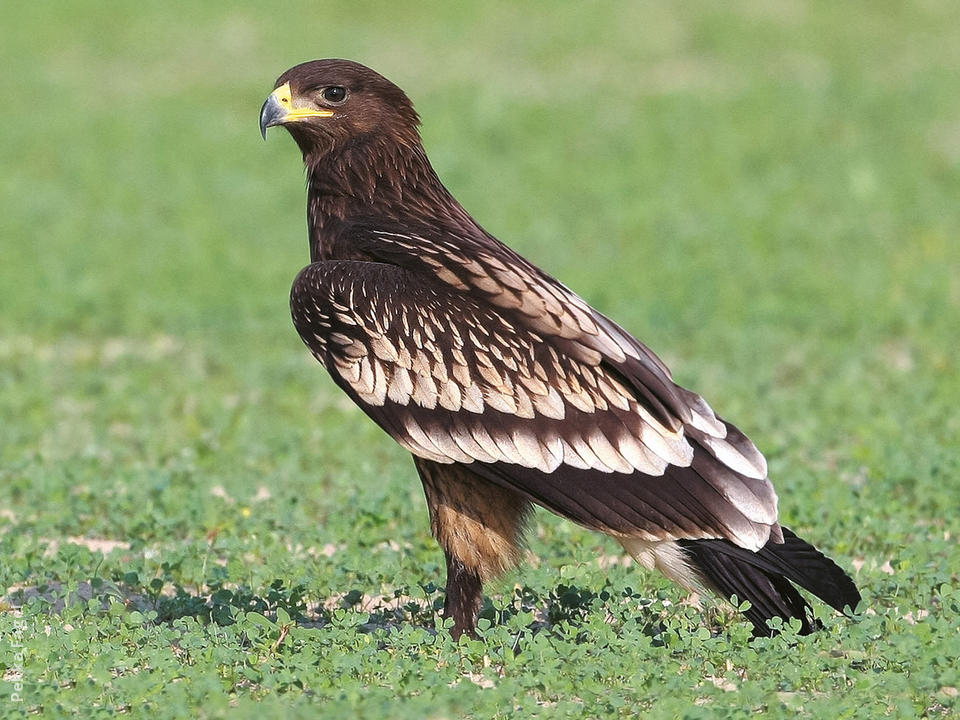
Greater Spotted Eagle
Clanga clanga
Order:
Family:
Size:
59-71 cm
Weight:
M 1500-1900 g, F 1800-2500 g
Taxonomy:
Monotypic Aquila Clanga (Pallas, 1811)
Short Description:
The greater spotted eagle (Clanga clanga), occasionally just called the spotted eagle, is a large bird of prey. Like all typical eagles, it belongs to the family Accipitridae. The scientific name clanga is from Ancient Greek κλαγγή, "scream". The eagle is 59–71 cm (23–28 in) in length and has a wingspan of 157–179 cm (5.15–5.87 ft). Typical body mass is 1.6–2.5 kg (3.5–5.5 lb), with an occasional big female weighing up to 3.2 kg (7.1 lb). There is often a less obvious white patch on the upperwings, but a light crescent on the primary remiges is a good field mark. The white V mark on the rump is less clear-cut in adults than in the lesser spotted eagle (C. pomarina). The juvenile has white spots all over its wings and lacks a lighter nape patch. The call is a dog-like yip. This medium-sized eagle is very similar in general appearance to its closest relative the lesser spotted eagle, which shares part of its range. Head and wing coverts are very dark brown and contrast with the generally medium brown plumage; the lesser spotted eagle has a paler head and wing coverts. The head is small for an eagle. The similarities of the greater spotted to the lesser spotted often results in misidentification as being that species. This is further complicated by occasional hybrids between the two species. In winter, it occurs in the range of the Indian spotted eagle (C. hastata). From this recently validated relative, it can be distinguished by the darker color and lighter eye (not darker than the body plumage at distance, lighter at close range), and in juveniles, the strong spotting. It is also a bit larger – though this cannot be reliably estimated in the field – and in the winter quarters prefers wetland habitat. This is a species of wooded country. The population is entirely migratory. It breeds from northern Europe eastwards across Eurasia, and winters in south-eastern Europe, north-eastern Africa, the Middle East and the Indian Subcontinent. Migration to the breeding grounds takes place fairly late; in Bhutan, for example, birds can be seen with some regularity until the end of March. In its winter range, the species is more social than when breeding. Small flocks of up to ten birds or so, of varying age, can be seen to patrol the land together. They also associate with other Accipitridae such as local and/or migrant black kites (Milvus migrans lineatus and govinda) or steppe eagles (A. nipalensis), distinctly smaller and larger raptors, respectively. In Pakistan, Greater Spotted Eagles are common winter visitor, preferring vicinity of large lakes, barrage headponds and large canals. Rare breeder in better wooded parts of Sind. Few Breeding records from Head Marala.
Far far away, behind the word mountains, far from the countries Vokalia and Consonantia, there live the blind texts. Separated they live in Bookmarksgrove right at the coast
Lahore, Bahawalpur ,Rahim Yar Khan, Kasur, Faisalabad, Multan, Attock,Chakwal,Gujranwala,Gujrat,Hafizabad,Jhang,Jhelum,Khanewal,Khushab,Mandi Baha Uddin, Mainsail, Narowal, Nankana Sahib, Rawalpindi, Sargodha,Sialkot, Toba Tek Singh, Badin, Karachi Central, Khairpur
Greater Spotted Eagle (Clanga clanga) is a majestic bird of prey known for its versatile hunting strategies and territorial behavior. Primarily a solitary hunter, it preys on small mammals, birds, and occasionally reptiles, often hunting from a perch or while flying low over open areas. During the breeding season, Greater Spotted Eagles fiercely defend their nesting territories, engaging in aerial displays and vocalizations to deter intruders. They construct large stick nests in forested areas, near wetlands or open habitats, where both parents participate in incubating the eggs and caring for the young. As migratory birds, they undertake long-distance journeys between breeding and wintering grounds, showcasing their adaptability to diverse environments. Overall, the Greater Spotted Eagle’s behavior reflects its prowess as a skilled hunter and its commitment to ensuring the survival of its offspring.
Far far away, behind the word mountains, far from the countries Vokalia and Consonantia, there live the blind texts. Separated they live in Bookmarksgrove right at the coast
About Photographer : Hello World
Facebook
Twitter
Instagram
Flicker
LinkedIn

